Citroen GRAND C4 PICASSO RHD 2016 2.G Owner's Manual
Manufacturer: CITROEN, Model Year: 2016, Model line: GRAND C4 PICASSO RHD, Model: Citroen GRAND C4 PICASSO RHD 2016 2.GPages: 523, PDF Size: 13.63 MB
Page 231 of 523
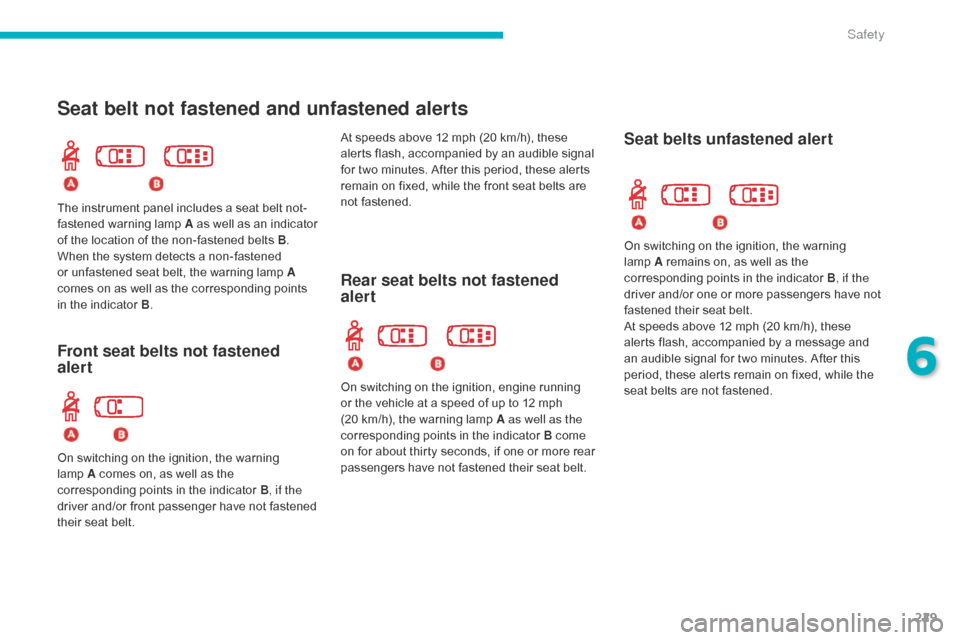
229
Seat belt not fastened and unfastened alerts
Rear seat belts not fastened
alert
Theô instrumentô panelô includesô aô seatô beltô not-
f astenedô w arningô lam pô A ô asô wellô asô anô indicatorô o
f ô the ô location ô of ô the ô non-fastened ô belts ô B.
When
ô the ô system ô detects ô a ô non-fastened ô
o
r ô unfastened ô seat ô belt, ô the ô warning ô lamp ô A
comes
ô on ô as ô well ô as ô the ô corresponding ô points ô
i
n ô the ô indicator ô B.
On
ô switching ô on ô the ô ignition, ô engine ô running ô
o
r ô the ô vehicle ô at ô a ô speed ô of ô up ô to ô 12 ô mph ô
(
20 ô km/h), ô the ô warning ô lamp ô A as well as the
corresponding
ô points ô in ô the ô indicator ô B ô come ô
o
n ô for ô about ô thirty ô seconds, ô if ô one ô or ô more ô rear ô
p
assengers ô have ô not ô fastened ô their ô seat ô belt.
Seat belts unfastened alert
Front seat belts not fastened
alert
Onô switchingô onô theô ignition,ô theô warningô lam pô A ô comes ô on, ô as ô well ô as ô the ô
c
orrespondingô points ô in ô the ô indicator ô B, if the
driver
ô and/or ô front ô passenger ô have ô not ô fastened ô
t
heir ô seat ô belt. At
ô speeds ô above ô 12 ô mph ô (20 ô km/h), ô these ô
a
lerts ô flash, ô accompanied ô by ô an ô audible ô signal ô
f
or ô two ô minutes. ô After ô this ô period, ô these ô alerts ô
r
emain ô on ô fixed, ô while ô the ô front ô seat ô belts ô are ô
n
ot ô fastened.
On ô switching ô on ô the ô ignition, ô the ô warning ô
lam
p
ô A
ô remains ô on, ô as ô well ô as ô the ô
c
orresponding ô points ô in ô the ô indicator ô B
, if the
driver ô and/or ô one ô or ô more ô passengers ô have ô not ô
f
astened ô their ô seat ô belt.
At ô speeds ô above ô 12 ô mph ô (20 ô km/h), ô these ô
a
lerts ô flash, ô accompanied ô by ô a ô message ô and ô
a
n ô audible ô signal ô for ô two ô minutes. ô After ô this ô
p
eriod, ô these ô alerts ô remain ô on ô fixed, ô while ô the ô
s
eat ô belts ô are ô not ô fastened.
6
Safety
Page 232 of 523
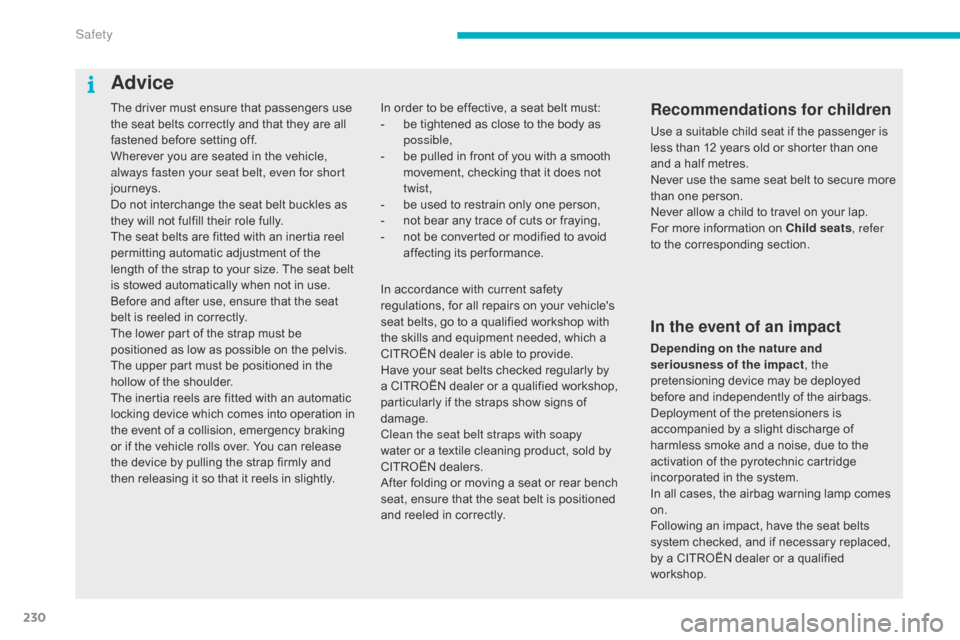
230
Theô driverô mustô ensureô thatô passengersô useô the ô seat ô belts ô correctly ô and ô that ô they ô are ô all ô
f
astened ô before ô setting ô off.
Wherever
ô you ô are ô seated ô in ô the ô vehicle, ô
a
lways fasten your seat belt, even for short
journeys.
Do
ô not ô interchange ô the ô seat ô belt ô buckles ô as ô
t
hey ô will ô not ô fulfill ô their ô role ô fully.
The
ô seat ô belts ô are ô fitted ô with ô an ô inertia ô reel ô
p
ermitting ô automatic ô adjustment ô of ô the ô
l
ength ô of ô the ô strap ô to ô your ô size. ô The ô seat ô belt ô
i
s ô stowed ô automatically ô when ô not ô in ô use.
Before
ô and ô after ô use, ô ensure ô that ô the ô seat ô
b
elt ô is ô reeled ô in ô correctly.
The
ô lower ô part ô of ô the ô strap ô must ô be ô
p
ositioned ô as ô low ô as ô possible ô on ô the ô pelvis.
The
ô upper ô part ô must ô be ô positioned ô in ô the ô
h
ollow ô of ô the ô shoulder.
The
ô inertia ô reels ô are ô fitted ô with ô an ô automatic ô
l
ocking ô device ô which ô comes ô into ô operation ô in ô
t
he ô event ô of ô a ô collision, ô emergency ô braking ô
o
r ô if ô the ô vehicle ô rolls ô over. ô You ô can ô release ô
t
he ô device ô by ô pulling ô the ô strap ô firmly ô and ô
t
hen ô releasing ô it ô so ô that ô it ô reels ô in ô slightly.Recommendations for children
Useô aô suitableô childô seatô ifô theô passengerô isô less ô than ô 12 ô years ô old ô or ô shorter ô than ô one ô
a
nd ô a ô half ô metres.
Never
ô use ô the ô same ô seat ô belt ô to ô secure ô more ô
t
han ô one ô person.
Never
ô allow ô a ô child ô to ô travel ô on ô your ô lap.
For
ô more ô information ô on ô Child seats, refer
to
ô the ô corresponding ô section.
In
ô
order
ô
to
ô
be
ô
effective,
ô
a
ô
seat
ô
belt
ô
must:
-
ô b
e
ô
tightened
ô
as
ô
close
ô
to
ô
the
ô
body
ô
as
ô p
ossible,
-
ô
b
e
ô
pulled
ô
in
ô
front
ô
of
ô
you
ô
with
ô
a
ô
smooth
ô
m
ovement,
ô
checking
ô
that
ô
it
ô
does
ô
not
ô
t
wist,
-
ô
b
e
ô
used
ô
to
ô
restrain
ô
only
ô
one
ô
person,
-
ô
n
ot
ô
bear
ô
any
ô
trace
ô
of
ô
cuts
ô
or
ô
fraying,
-
ô
n
ot
ô
be
ô
converted
ô
or
ô
modified
ô
to
ô
avoid
ô
a
ffecting
ô it
s
ô p
erformance.
In the event of an impact
Depending on the nature and
seriousness of the impact , the
pretensioning
ô device ô may ô be ô deployed ô
b
efore ô and ô independently ô of ô the ô airbags. ô
D
eployment ô of ô the ô pretensioners ô is ô
a
ccompanied ô by ô a ô slight ô discharge ô of ô
h
armless ô smoke ô and ô a ô noise, ô due ô to ô the ô
a
ctivation ô of ô the ô pyrotechnic ô cartridge ô
i
ncorporated ô in ô the ô system.
In
ô all ô cases, ô the ô airbag ô warning ô lamp ô comes ô
o
n.
Following
ô an ô impact, ô have ô the ô seat ô belts ô
s
ystem ô checked, ô and ô if ô necessary ô replaced, ô
b
y ô a ô CITROûN ô dealer ô or ô a ô qualified ô
w
orkshop.
In
ô
accordance
ô
with
ô
current
ô
safety
ô
r
egulations,
ô
for
ô
all
ô
repairs
ô
on
ô
your
ô
vehicle's
ô
s
eat
ô
belts,
ô
go
ô
to
ô
a
ô
qualified
ô
workshop
ô
with
ô t
he
ô
skills
ô
and
ô
equipment
ô
needed,
ô
which
ô
a
ô C
ITROûN
ô
dealer
ô
is
ô
able
ô
to
ô
provide.
Have
ô
your
ô
seat
ô
belts
ô
checked
ô
regularly
ô
by
ô
a
ô
CITROûN
ô
dealer
ô
or
ô
a
ô
qualified
ô
workshop,
ô
p
articularly
ô
if
ô
the
ô
straps
ô
show
ô
signs
ô
of
ô
d
amage.
Clean the seat belt straps with soapy
water
ô
or
ô
a
ô
textile
ô
cleaning
ô
product,
ô
sold
ô
by
ô
C
ITROûN
ô
dealers.
After
ô
folding
ô
or
ô
moving
ô
a
ô
seat
ô
or
ô
rear
ô
bench
ô
s
eat,
ô
ensure
ô
that
ô
the
ô
seat
ô
belt
ô
is
ô
positioned
ô
a
nd
ô
reeled
ô
in
ô
correctly.
Advice
Safety
Page 233 of 523
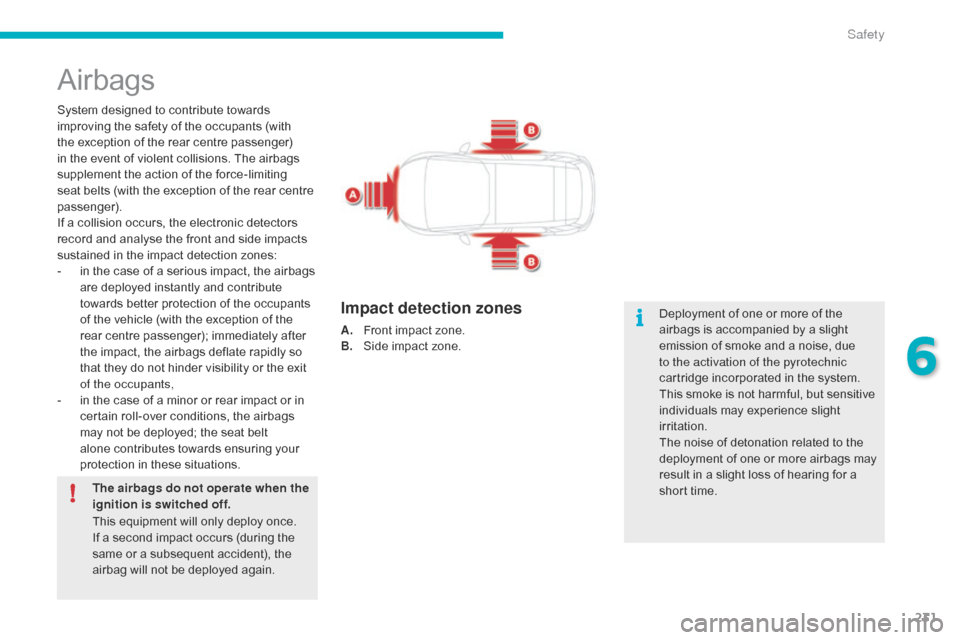
231
Airbags
Systemô designedô toô contributeô towardsô improving ô the ô safety ô of ô the ô occupants ô (with ô
t
he ô exception ô of ô the ô rear ô centre ô passenger) ô
i
n ô the ô event ô of ô violent ô collisions. ô The ô airbags ô
s
upplement ô the ô action ô of ô the ô force-limiting ô
s
eat ô belts ô (with ô the ô exception ô of ô the ô rear ô centre ô
p
assenger).
If
ô a ô collision ô occurs, ô the ô electronic ô detectors ô
r
ecord ô and ô analyse ô the ô front ô and ô side ô impacts ô
s
ustained ô in ô the ô impact ô detection ô zones:
-
ô
i
n ô the ô case ô of ô a ô serious ô impact, ô the ô airbags ô
a
re ô deployed ô instantly ô and ô contribute ô
t
owards ô better ô protection ô of ô the ô occupants ô
o
f ô the ô vehicle ô (with ô the ô exception ô of ô the ô
r
ear ô centre ô passenger); ô immediately ô after ô
t
he ô impact, ô the ô airbags ô deflate ô rapidly ô so ô
t
hat ô they ô do ô not ô hinder ô visibility ô or ô the ô exit ô
o
f the occupants,
-
ô
i
n ô the ô case ô of ô a ô minor ô or ô rear ô impact ô or ô in ô
c
ertain ô roll-over ô conditions, ô the ô airbags ô
m
ay ô not ô be ô deployed; ô the ô seat ô belt ô
a
lone ô contributes ô towards ô ensuring ô your ô
p
rotection ô in ô these ô situations.
The airbags do not operate when the
ignition is switched off.
This
ô equipment ô will ô only ô deploy ô once. ô
I
f ô a ô second ô impact ô occurs ô (during ô the ô
s
ame ô or ô a ô subsequent ô accident), ô the ô
a
irbag ô will ô not ô be ô deployed ô again. Deployment
ô of ô one ô or ô more ô of ô the ô
a
irbags ô is ô accompanied ô by ô a ô slight ô
e
mission ô of ô smoke ô and ô a ô noise, ô due ô
t
o the activation of the pyrotechnic
cartridge
ô incorporated ô in ô the ô system.
This
ô smoke ô is ô not ô harmful, ô but ô sensitive ô
i
ndividuals ô may ô experience ô slight ô
ir
ritation.
The
ô noise ô of ô detonation ô related ô to ô the ô
d
eployment ô of ô one ô or ô more ô airbags ô may ô
r
esult ô in ô a ô slight ô loss ô of ô hearing ô for ô a ô
s
hort ô time.
Impact detection zones
A.ô Frontô impact ô zone.
B.ô S ide ô impact ô zone.
6
Safety
Page 234 of 523

232
Deactivation
Whenô theô ignitionô isô on,ô thisô warningô lamp ô comes ô in ô the ô instrument ô
p
anel. ô It ô stays ô on ô while ô the ô airbag ô is ô
d
eactivated.
Front airbags
Deployment
Theô airbagsô areô deployed,ô exceptô theô p assenger's ô front ô airbag ô if ô it ô is ô deactivated, ô in ô the ô
e
vent ô of ô a ô serious ô front ô impact ô to ô all ô or ô part ô of ô the ô
f
ront ô impact ô zone ô A,
ô in ô the ô longitudinal ô centreline ô
o
f ô the ô vehicle ô on ô a ô horizontal ô plane ô and ô directed ô
f
rom ô the ô front ô to ô the ô rear ô of ô the ô vehicle.
The
ô front ô airbag ô inflates ô between ô the ô thorax ô and ô
h
ead ô of ô the ô front ô occupant ô of ô the ô vehicle ô and ô the ô
s
teering ô wheel, ô driver's ô side, ô and ô the ô dashboard, ô
p
assenger's ô side ô to ô cushion ô their ô for ward ô
m
ovement.
Systemô whichô protectsô theô driverô andô frontô passenger ô in ô the ô event ô of ô a ô serious ô front ô impact ô
i
n ô order ô to ô limit ô the ô risk ô of ô injury ô to ô the ô head ô and ô
t
horax.
The
ô driver's ô airbag ô is ô fitted ô in ô the ô centre ô of ô the ô
s
teering ô wheel; ô the ô front ô passenger's ô airbag ô is ô
f
itted ô in ô the ô dashboard ô above ô the ô glove ô box.Only
ô the ô passenger's ô front ô airbag ô can ô be ô
d
eactivated.
F
W
ith the ignition off,
ô insert ô the ô key ô in ô the ô
p
assenger ô airbag ô deactivation ô switch.
F
T
urn it to the "OFF"
ô p
osition.
F
ô
R
emove ô the ô key ô keeping ô the ô switch ô in ô the ô
n
ew ô position.To
ô assure ô the ô safety ô of ô your ô child, ô
t
he ô passenger's ô front ô airbag ô must ô be ô
d
eactivated ô when ô you ô install ô a ô rear ward ô
f
acing ô child ô seat ô on ô the ô front ô passenger ô
sea
t.
Other wise, ô the ô child ô would ô risk ô being ô
s
eriously ô injured ô or ô killed ô if ô the ô airbag ô
w
ere ô deployed.
Reactivation
Whenô youô removeô theô rear wardô facingô childô sea
t, with the ignition off , turn the switch to
the "ON"
ô
position ô to ô reactivate ô the ô airbag ô and ô
s
o ô assure ô the ô safety ô of ô your ô front ô passenger ô in ô
t
he ô event ô of ô an ô impact.
When
ô the ô ignition ô is ô switched ô on, ô
t
his ô warning ô lamp ô comes ô on ô in ô the ô
i
nstrument ô panel ô for ô approximately ô
o
ne ô minute ô to ô signal ô that ô the ô front ô
a
irbag ô is ô activated.
Operating fault
Ifô thisô warningô lampô comesô onô inô theô instrument ô panel, ô you ô must ô contact ô
a
ô CITROûN ô dealer ô or ô a ô qualified ô
w
orkshop ô to ô have ô the ô system ô checked.
The
ô airbags ô may ô no ô longer ô be ô deployed ô
i
n ô the ô event ô of ô a ô serious ô impact.
Safety
Page 235 of 523
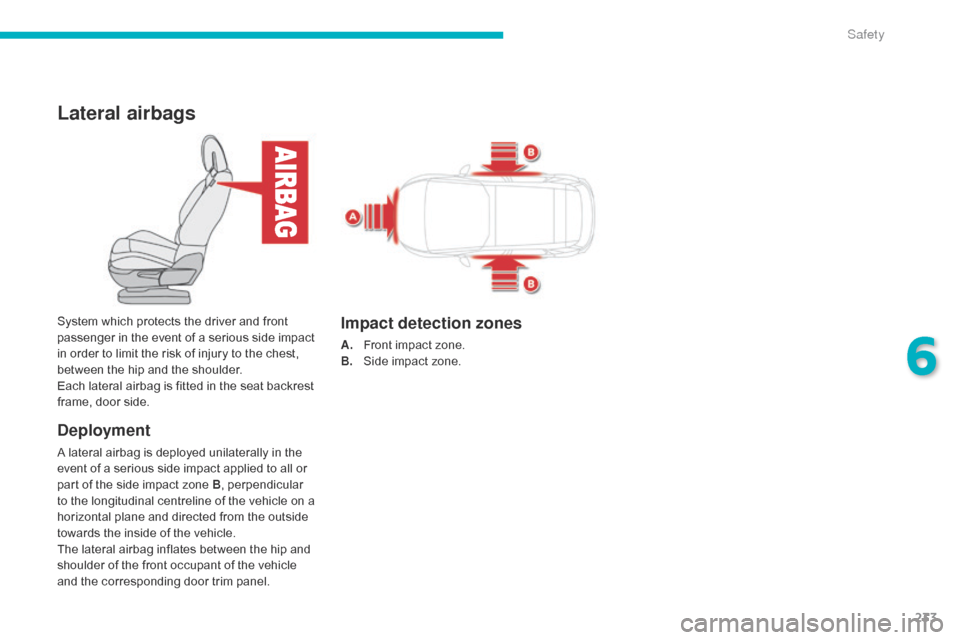
233
Lateral airbags
Deployment
Aô lateralô airbagô isô deployedô unilaterallyô inô theô event ô of ô a ô serious ô side ô impact ô applied ô to ô all ô or ô
p
art ô of ô the ô side ô impact ô zone ô B, ô perpendicular ô
t
o ô the ô longitudinal ô centreline ô of ô the ô vehicle ô on ô a ô
h
orizontal ô plane ô and ô directed ô from ô the ô outside ô
t
owards ô the ô inside ô of ô the ô vehicle.
The
ô lateral ô airbag ô inflates ô between ô the ô hip ô and ô
s
houlder ô of ô the ô front ô occupant ô of ô the ô vehicle ô
a
nd ô the ô corresponding ô door ô trim ô panel.
System
ô which ô protects ô the ô driver ô and ô front ô
p
assenger ô in ô the ô event ô of ô a ô serious ô side ô impact ô
i
n ô order ô to ô limit ô the ô risk ô of ô injury ô to ô the ô chest, ô
b
etween ô the ô hip ô and ô the ô shoulder.
Each ô lateral ô airbag ô is ô fitted ô in ô the ô seat ô backrest ô
f
rame, ô door ô side.
Impact detection zones
A.ô Front
ô impact ô zone.
B.ô S ide ô impact ô zone.
6
Safety
Page 236 of 523
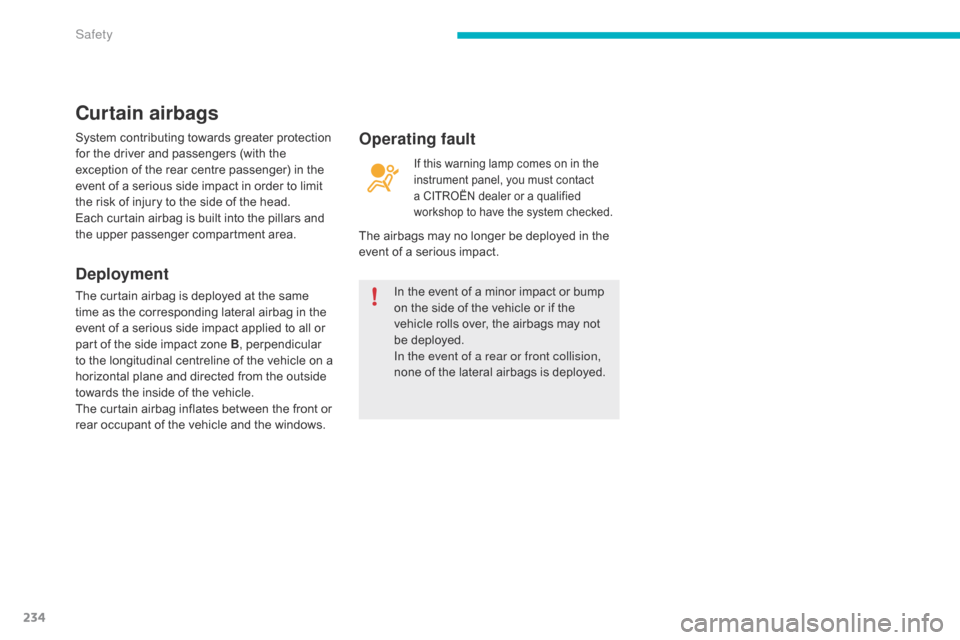
234
Inô theô eventô ofô aô minorô impactô orô bumpô on ô the ô side ô of ô the ô vehicle ô or ô if ô the ô
v
ehicle ô rolls ô over, ô the ô airbags ô may ô not ô
b
e ô deployed.
In the event of a rear or front collision,
none
ô of ô the ô lateral ô airbags ô is ô deployed.
System
ô
contributing
ô
towards
ô
greater
ô
protection
ô
f
or
ô
the
ô
driver
ô
and
ô
passengers
ô
(with
ô
the
ô
e
xception
ô
of
ô
the
ô
rear
ô
centre
ô
passenger)
ô
in
ô
the
ô
e
vent
ô
of
ô
a
ô
serious
ô
side
ô
impact
ô
in
ô
order
ô
to
ô
limit
ô
t
he
ô
risk
ô
of
ô
injury
ô
to
ô
the
ô
side
ô
of
ô
the
ô
head.
Each
ô
curtain
ô
airbag
ô
is
ô
built
ô
into
ô
the
ô
pillars
ô
and
ô
t
he
ô
upper
ô
passenger
ô
compartment
ô
area.
Curtain airbags
Deployment
Theô curtainô airbagô isô deployedô atô theô sameô t
ime ô as ô the ô corresponding ô lateral ô airbag ô in ô the ô
e
vent ô of ô a ô serious ô side ô impact ô applied ô to ô all ô or ô
p
art ô of ô the ô side ô impact ô zone ô B, ô perpendicular ô
t
o ô the ô longitudinal ô centreline ô of ô the ô vehicle ô on ô a ô
h
orizontal ô plane ô and ô directed ô from ô the ô outside ô
t
owards ô the ô inside ô of ô the ô vehicle.
The
ô curtain ô airbag ô inflates ô between ô the ô front ô or ô
r
ear ô occupant ô of ô the ô vehicle ô and ô the ô windows.
Ifô thisô warningô lampô comesô onô inô theô instrument ô panel, ô you ô must ô contact ô
a
ô CITROûN ô dealer ô or ô a ô qualified ô
w
orkshop ô to ô have ô the ô system ô checked.
Operating fault
Theô airbagsô mayô noô longerô beô deployedô inô theô event ô of ô a ô serious ô impact.
Safety
Page 237 of 523

235
Sitô inô aô normalô uprightô position.
W ear ô a ô correctly ô adjusted ô seat ô belt.
Do
ô not ô leave ô anything ô between ô the ô
o
ccupants ô and ô the ô airbags ô (a ô child, ô pet, ô
o
bject...), ô nor ô fix ô or ô attach ô anything ô close ô to ô
t
he ô inflation ô trajectory ô of ô the ô airbags; ô this ô
c
ould ô cause ô injuries ô during ô their ô deployment.
Never
ô modify ô the ô original ô definition ô of ô your ô
v
ehicle, ô particularly ô in ô the ô area ô directly ô
a
round ô the ô airbags.
After
ô an ô accident ô or ô if ô the ô vehicle ô has ô been ô
s
tolen ô or ô broken ô into, ô have ô the ô airbag ô
s
ystems ô checked.
All
ô work ô on ô the ô airbag ô system ô must ô be ô
c
arried ô out ô by ô a ô CITROûN ô dealer ô or ô a ô
q
ualified
ô w
orkshop.
Even
ô if ô all ô of ô the ô precautions ô mentioned ô
a
re ô observed, ô a ô risk ô of ô injury ô or ô of ô minor ô
b
urns ô to ô the ô head, ô chest ô or ô arms ô when ô an ô
a
irbag ô is ô deployed ô cannot ô be ô ruled ô out. ô The ô
b
ag ô inflates ô almost ô instantly ô (within ô a ô few ô
m
illiseconds) ô then ô deflates ô within ô the ô same ô
t
ime ô discharging ô the ô hot ô gas ô via ô openings ô
p
rovided ô for ô this ô purpose.Front airbags
Doô notô driveô holdingô theô steeringô wheelô byô itsô spokes ô or ô resting ô your ô hands ô on ô the ô centre ô
p
art ô of ô the ô wheel.
Passengers
ô must ô not ô place ô their ô feet ô on ô the ô
das
hboard.
Do
ô not ô smoke ô as ô deployment ô of ô the ô airbags ô
c
an ô cause ô burns ô or ô the ô risk ô of ô injury ô from ô a ô
c
igarette ô or ô pipe.
Never
ô
remove
ô
or
ô
pierce
ô
the
ô
steering
ô
wheel
ô
or
ô h
it ô it ô violently.
Do
ô not ô fit ô or ô attach ô anything ô to ô the ô steering ô
w
heel ô or ô dashboard, ô this ô could ô cause ô
i
njuries ô with ô deployment ô of ô the ô airbags.
Advice
Lateral airbags
Useô onlyô approvedô coversô onô theô seats,ô compatible ô with ô the ô deployment ô the ô lateral ô
a
irbags. ô For ô information ô on ô the ô range ô of ô seat ô
c
overs suitable for your vehicle, you can
contact
ô a ô CITROûNô dealer.
For
ô more ô information ô on ô Accessories, refer
to
ô the ô corresponding ô section.
Do
ô not ô fix ô or ô attach ô anything ô to ô the ô seat ô
b
acks ô (clothing...). ô This ô could ô cause ô injury ô
t
o ô the ô chest ô or ô arms ô if ô the ô lateral ô airbag ô is ô
d
eployed.
Do
ô not ô sit ô with ô the ô upper ô part ô of ô the ô body ô any ô
n
earer ô to ô the ô door ô than ô necessary.
Curtain airbags
Doô notô fixô orô attachô anythingô toô theô roof.ô Thisô could ô cause ô injury ô to ô the ô head ô if ô the ô curtain ô
a
irbag ô is ô deployed.
If
ô fitted ô on ô your ô vehicle, ô do ô not ô remove ô the ô
g
rab ô handles ô installed ô on ô the ô roof, ô they ô play ô
a
ô part ô in ô securing ô the ô curtain ô airbags.
For the airbags to be fully effective, observe the safety recommendations below:
6
Safety
Page 238 of 523
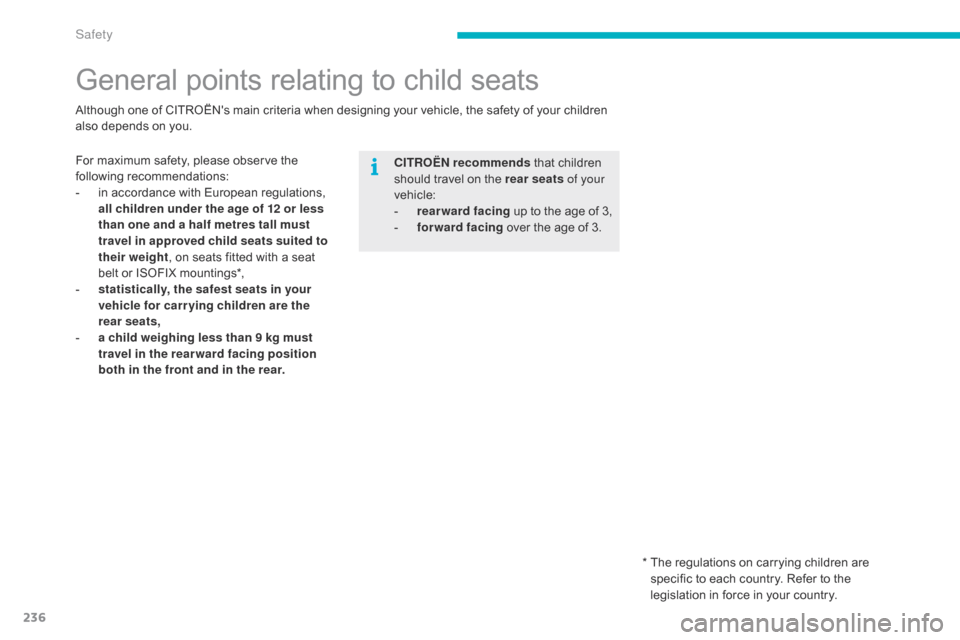
236
Generalô pointsô relatingô toô childô seats
Forô maximumô safety,ô pleaseô observeô theô followingô r ecommendations:
-
ô
i
n ô accordance ô with ô European ô regulations, ô
a
ll children under the age of 12 or less
than one and a half metres tall must
travel in approved child seats suited to
their weight ,
ô on ô seats ô fitted ô with ô a ô seat ô
b
elt ô or ô ISOFIX ô mountings*,
-
ô
s
tatistically, the safest seats in your
vehicle for carr ying children are the
rear seats,
-
ô
a c
hild weighing less than 9 kg must
travel in the rear ward facing position
both in the front and in the rear. CITROûN recommendsô
that ô children ô
s
hould ô travel ô on ô the ô rear seats of your
vehicle:
-
ô
re
arward facing
ô
up ô to ô the ô age ô of ô 3,
-
ô
fo
rward facing
ô
over ô the ô age ô of ô 3.
Although
ô one ô of ô CITROûN's ô main ô criteria ô when ô designing ô your ô vehicle, ô the ô safety ô of ô your ô children ô
a
lso ô depends ô on ô you.
* ô ô
T
he ô regulations ô on ô carrying ô children ô are ô
s
pecific ô to ô each ô country. ô Refer ô to ô the ô
l
egislation ô in ô force ô in ô your ô country.
Safety
Page 239 of 523
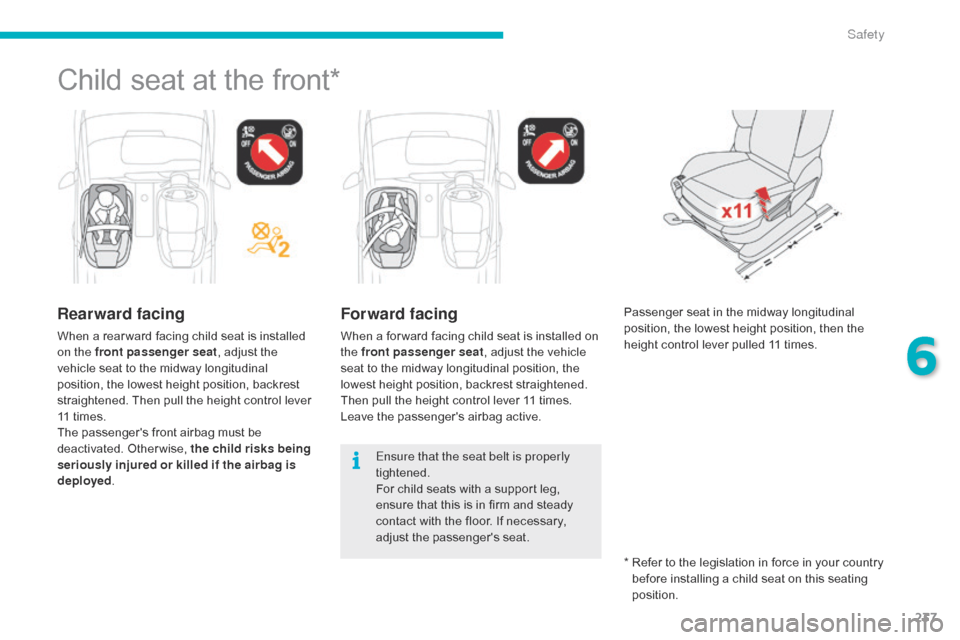
237
Childô seatô atô theô front*
Rearward facing
Whenô aô rear wardô facingô childô seatô isô installedô on the front passenger seat ,
ô adjust ô the ô
v
ehicle ô seat ô to ô the ô midway ô longitudinal ô
p
osition, ô the ô lowest ô height ô position, ô backrest ô
s
traightened. ô Then ô pull ô the ô height ô control ô lever ô
1
1 ô times.
The
ô passenger's ô front ô airbag ô must ô be ô
d
eactivated.
ô O
therwise,
ô t
he child risks being
seriously injured or killed if the airbag is
deployed .
Forward facing
Whenô aô for wardô facingô childô seatô isô installedô onô t
he front passenger seat ,
ô adjust ô the ô vehicle ô
s
eat ô to ô the ô midway ô longitudinal ô position, ô the ô
l
owest ô height ô position, ô backrest ô straightened. ô
T
hen ô pull ô the ô height ô control ô lever ô 11 ô times. ô
L
eave ô the ô passenger's ô airbag ô active.Passenger
ô seat ô in ô the ô midway ô longitudinal ô p
osition, ô the ô lowest ô height ô position, ô then ô the ô h
eight ô control ô lever ô pulled ô 11 ô times.
Ensure that the seat belt is properly
tightened.
For
ô child ô seats ô with ô a ô support ô leg, ô
e
nsure ô that ô this ô is ô in ô firm ô and ô steady ô
c
ontact ô with ô the ô floor. ô If ô necessary, ô
a
djust
ô t
he
ô p
assenger's
ô sea
t.*
ô ô
R
efer ô to ô the ô legislation ô in ô force ô in ô your ô country ô
b
efore ô installing ô a ô child ô seat ô on ô this ô seating ô
p
osition.
6
Safety
Page 240 of 523

238
Deactivatingô theô passenger'sô frontô airbag
Passenger airbag OFF
Forô informationô onô deactivatingô theô passenger's ô front ô airbag, ô refer ô to ô the ô
"
Airbags" ô section.
Never
ô
install
ô
a
ô
rear ward
ô
facing
ô
child
ô
r
estraint
ô
system
ô
on
ô
a
ô
seat
ô
protected
ô
by
ô
a
n
ô
active
ô
front
ô
airbag.
ô
This
ô
could
ô
cause
ô
t
he
ô
death
ô
of
ô
the
ô
child
ô
or
ô
serious
ô
injury.
The
ô
warning
ô
label
ô
present
ô
on
ô
both
ô
sides
ô
of
ô
the
ô
p
assenger's
ô
sun
ô
visor
ô
repeats
ô
this
ô
advice.
ô
In
ô
l
ine
ô
with
ô
current
ô
legislation,
ô
the
ô
following
ô
tables
ô
c
ontain
ô
this
ô
warning
ô
in
ô
all
ô
of
ô
the
ô
languages
ô
r
equired.
Safety